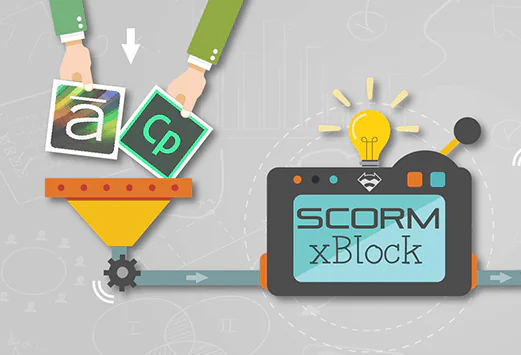The Learning record store (LRS) does just that. As a new architecture for learning, the LRS comes with a multitude of features and taps into sophisticated technologies to provide learners with an engaging eLearning experience. Let’s find out what is learning record store (LRS):
What is a Learning Record Store (LRS)?
To know what is a learning record store, it’s important to understand Experience API (xAPI). Most eLearning modules communicate with LMSs through a concept called SCORM (Shareable Content Object Reference Model). While the standard was established in 2001, the way it’s used in the workplace has greatly evolved. Today, SCORM-compliant LMS solutions continue to support formal learning, while xAPI enables tracking of more dynamic, experiential learning activities. There has been a shift in focus from formal learning to social and more experiential learning.
Apart from SCORM, API standard and AICC standards were also used, none of these couldn’t align with the advancements in technology. To meet future requirements, the Advanced Distributed Learning (ADL) released Experience API (xAPI) in collaboration with Rustici Software. Since then, the xAPI has replaced the previous standards and rapidly taken over the field of eLearning.
What makes xAPI exciting is its high flexibility to describe learning experiences and the storing of learning data beyond what goes on in the LMS. Previously, organizations would record online learning experiences when learners logged in to their LMS accounts and completed the SCORM module. With xAPI, the source doesn’t have to be a SCORM module. It can be a mobile app, pages on an intranet, or even an offline experience.
While a SCORM records learning data as a single line of code with all spaces removed, xAPI uses an extremely flexible format to store learning experiences.
The way xAPI functions is where the learning record store comes into play. According to the Experience API Working Group, the Learning record store is a system or server designed to receive, store, and provide access to learning records.
As a critical element of an xAPI-powered ecosystem, the LRS is where the learning experience data is stored in the form of xAPI statements. Without the LRS, no tracking of performance and learning would be possible, nor would the experiences be stored. In other words, this server-side component of xAPI makes tracking and recording of learning and other experiences possible. LRS and xAPI software are thus inextricably linked to each other.
Why Not Simply Use an LMS?
An ordinary LMS helps you easily track formal or structured learning. The modern workplace is, however, characterized by both formal and informal learning. Since organizations need to effectively track both formal and informal, they have been forced to consider technologies such as LRS and xAPI.
They prove valuable in helping administrators track what happens outside the core LMS, providing them with tremendous insights into learner behavior. The insights can then be used to refine the training content as well as make important decisions concerning employees and their salaries.
Just by comparing the two names, you’ll realize that LRS and LMS are two completely different solutions. An LMS is an integrated learning platform that’s primarily used to deploy training and track learner performances within the program. On the other hand, LRS tracks and stores xAPI data that are created in an LMS or another platform used to deploy training. It can be built into an LMS to record learner data and upgrade reporting. It can also be hosted externally and linked to the LMS.
What LRS Enables?
The LRS is designed to obtain data from a range of experiences. It enables modern tracking of a variety of learning experiences such as job performances and real-world activities completed on mobile apps. An LRS doesn’t just store data from these experiences but also shares it with other platforms that support adaptive learning experiences or offer advanced reporting.
Once the LRS gathers data from the experiences, the different sets of data are compared and collated to determine the effectiveness of learning solutions and training programs.
LRS as a Standalone System
While LRS can be integrated with an LMS, it typically comes as a standalone application containing a range of analytics and LMS reporting features. When used a separate system, it’s either installed on your computer or offered based on the Software as a Service (SaaS) model.
Many industry players believe that you’re better off with the LRS as a standalone application. Using it with an LMS takes away the massive flexibility offered by LRS. An LMS only stores learning records. Even if integrate LRS into it, the types of activities that can be recorded will be limited. In contrast, LRS as a standalone application helps you record a wide range of experiences. That’s the reason it seems unjust to call it just a learning record store.
You can store all sorts of trackable experiences including the experience of a discussion group, video, mobile app, simulators, games, books, and so on. Thus, the possibilities with LRS are endless. Most importantly, it offers an unmatched recording of performance data.
Besides, when it comes to scaling, nothing beats a separate LRS system. When integrated with an LMS, it doesn’t offer that level of scalability.
Key Features of LRS
A large number of organizations depend on LRS to enhance their training programs. The learning data it helps obtain is valuable to improve employee performance, ensure effective training, and foster business growth. To ensure that, LRS comprises of the following features:
High Flexibility
Can be used both as a standalone system or with an LMS. It functions smoothly in both scenarios.
Improved Data Capturing
It also offers tremendous flexibility in terms of what learning experiences can be recorded, especially when used as a separate system. It helps capture different types of data containing formal and informal learning experiences from both inside and outside of a learning environment.
Real-Time Assistance
Now that the remote working model is becoming more and more common among organizations, remote training is also replacing traditional training models. This means all stakeholders including learners, trainers, admin, etc. require remote access to learning and performance data. SaaS or cloud-based learning record stores provide them with real-time access to all the data, regardless of the place and time.
Wide Range of Applications
LRS can be used for different industrial applications. Whether you’re a software development company, an educational institution, or any other business, an LRS can be used to store learning experiences and use that data to improve the programs. Also, they can be integrated with a wide range of online platforms to serve your purpose.
Improved Learning
Through the interoperability of data, organizations are able to have a deeper understanding of learners’ needs and experiences and prepare training content accordingly. This adds an incredible amount of value to eLearning programs.
How LRS Works
When an LMS runs a course, the learner accesses a separate page outside the LMS that includes assessments in the form of games and any simulator required by the course. If a mobile app for the LMS exists, learners can access it from their smartphones. Even if an app is not available, learners can use the mobile version of the LMS on their mobile browsers.
Regardless of the way in which learners access learning content, learning experiences from both online and offline sources are reported to the LRS for storage in the form of xAPI statements. You can access this data through LMSs, other LRSs, or reporting tools, and store it as entire transcripts or individual learning records. An LRS will typically include dashboards and reporting functions specifically designed for interpretation and analysis. You may also configure the LRS to define permissions for users to read and write data to the LRS.
If an LRS lives inside an LMS, it will work within that LMS’s capabilities. The learning data or transcripts stored by an LRS, in this case, can be delivered to other LRSs within the LMS or those outside the LMS. The xAPI produces statements in [noun][verb][object] structure. Using this structure standardizes the way learning activities are reported, making it simpler to interpret data from a large number of sources.
Should You Get an LRS?
Whether or not you need an LRS depends on your resources, goals, and objectives. If you already work with an LMS, you might be thinking whether you an LRS. Many LMS providers build an LRS on their LMS products, but you need to consider your needs to make the right decision. If you wish to generate reports, you should be able to do that with an LMS. You don’t need an LRS for that.
However, it’s best to keep your LMS focused on the course and learning content and leave the management of xAPI data to a solution that specializes in that. Also, we also recommend an LRS if you have a large number of users to track or there are too many activities taking place at different sources. Tracking and recording all these activities create big data for eLearning, which provides you with more data to analyze.
If that’s not the case, you won’t be generating enough data for meaningful analysis to take place. You just won’t have enough touchpoints to analyze and thus, there won’t be a need for an LRS.
Benefits of LRS
When using an LMS, you don’t necessarily own the data. You can access reports but the data ultimately help and in control of the LMS provider. This is a big concern for organizations in eLearning. On an LRS, you own the data. You can download it, transfer it to other LRSs, or extract using xAPI.
Any device or software that can send HTTP requests can use xAPI to send data to LRSs or format the data correctly. When it can send data using xAPI, data can be sent to any LRS. Since the integration is not confined to an LMS, data can be obtained from any source and can be sent to any LRS.
Learning experiences are delivered via different platforms such as apps, LMSs, and websites, that won’t necessarily be accessed from formal learning environments. An LRS enables you to track and record data from all the different online and offline sources.
With the ability to store and record a vast amount of data, an LRS provides you with very detailed learning analytics. Its high adaptability and flexibility make it valuable for a wide range of industries such as education, manufacturing, IT, healthcare, etc.
Through the use of xAPI, LRSs help you track activities beyond the boundaries of learning. You can use the stored data to determine what drives high performances among learners and to create more personalized and improved learning experiences.
Drawbacks of LRS
Despite its unprecedented reporting capabilities, an LRS is not a full replacement of an LMS. There are many LMS functions that an LRS can’t do. For example, an LRS will not oversee student profiles, schedule classes, maintain course catalogs, and handle other administrative tasks that are offered by an LMS.
Final Word
You probably came to learn what is a learning record store but ended up learning a lot more about it. Whether you’re looking for a standalone LRS or wish to integrate it to your existing LMS, get in touch with Raccoon Gang. It will help you through the entire training lifecycle. To schedule a demo, click here.





